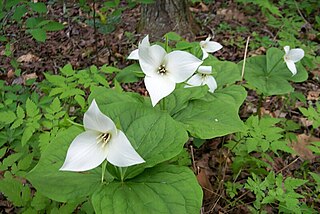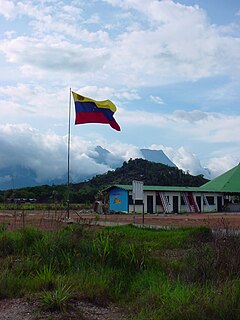
John Torrey was an American botanist, chemist, and physician. Throughout much of his career, Torrey was a teacher of chemistry, often at multiple universities, while at the same time pursuing botanical work. Dr. Torrey's botanical career focused on the flora of North America. His most renowned works include studies of the New York flora, the Mexican Boundary, the Pacific railroad surveys, as well as the uncompleted Flora of North America.

Nathaniel Lord Britton was an American botanist and taxonomist who co-founded the New York Botanical Garden in the Bronx, New York.

The Polyporaceae are a family of poroid fungi belonging to the Basidiomycota. The flesh of their fruit bodies varies from soft to very tough. Most members of this family have their hymenium in vertical pores on the underside of the caps, but some of them have gills or gill-like structures. Many species are brackets, but others have a definite stipe – for example, Polyporus badius.

Henry Allan Gleason (1882–1975) was an American ecologist, botanist, and taxonomist. He was known for his endorsement of the individualistic or open community concept of ecological succession, and his opposition to Frederic Clements's concept of the climax state of an ecosystem. His ideas were largely dismissed during his working life, leading him to move into plant taxonomy, but found favour late in the twentieth century.

Heliamphora tatei is a species of marsh pitcher plant endemic to Cerro Duida, Cerro Huachamacari and Cerro Marahuaca in Venezuela. It is closely related to H. macdonaldae, H. neblinae, and H. parva, and all three have in the past been considered forms or varieties of H. tatei. Like H. tatei, these species are noted for their stem-forming growth habit.

Trillium simile, the jeweled wakerobin, is a spring-flowering perennial plant which is native to southern parts of the Appalachian Mountains in southeastern United States. It is also known as sweet white wake-robin, sweet white trillium and confusing trillium.
Heliamphora macdonaldae is a species of marsh pitcher plant endemic to Venezuela. It is closely related to H. tatei and was for a long time considered a form or variety of that species. Putative natural hybrids between H. macdonaldae and H. tatei have been recorded in the southern part of Cerro Duida.
Torrey Botanical Society was started in the 1860s by colleagues of John Torrey. It is the oldest botanical society in the Americas. The Society promotes the exploration and study of plant life, with particular focus on the flora of the regions surrounding New York City. Members of the group including Nathaniel Lord Britton and his wife Elizabeth Gertrude Britton founded the New York Botanical Garden.
Ekmania is a genus of flowering plants in the daisy family. It contains only one known species, Ekmania lepidota, endemic to Cuba.

Eremosis is a genus of flowering plants in the daisy family.
Oreochrysum is a genus of flowering plants in the daisy family.

Mitrastemon is a genus of two widely disjunct species of parasitic plants. It is the only genus within the family Mitrastemonaceae. Mitrastemon species are root endoparasites, which grow on Fagaceae. It's also a non-photoysthetic plant that parasitizes other plants such as Castanopsis sieboldii. The parasitic plant was first discovered by botanist Eizi Matuda during an expedition to Mt. Ovando in the state of Chiapas, Mexico. The different species were originally named by a friend of Matuda, Yamamoto in 1925–1926. Mitrastemon yamamotoi is a protandrous plant. Its flowers go through a male phase before transforming into their final female form. The flowers of M. yamamotoi attract a variety of insects ranging from wasps to flies and beetles. Among these, beetles are the best pollinators for this plant since their visit to the flower would pick up a large amount of pollen and they would pollinate from each of the flowers that they had already visited. The plant is endemic to tropical and subtropical forest regions such as Southeast Asia and Japan.

Elizabeth Gertrude Britton was an American botanist, bryologist, and educator. She and her husband, Nathaniel Lord Britton played a significant role in the fundraising and creation of the New York Botanical Garden. She was a co-founder of the predecessor to the American Bryological and Lichenological Society. She was an activist for protection of wildflowers, inspiring local chapter activities and the passage of legislation. Elizabeth Britton made major contributions to the literature of mosses, publishing 170 papers in that field.

Edwin Butterworth Mains (1890–1968) was an American mycologist. He was known for his taxonomic research on the rust fungi (Pucciniomycetes), the genus Cordyceps, and the earth tongues (Geoglossaceae).
In phytosociology and community ecology an association is a type of ecological community with a predictable species composition and consistent physiognomy which occurs in a particular habitat type. The term was first coined by Alexander von Humboldt and formalised by the International Botanical Congress in 1910.

Cerro Duida, also known as Cerro Yennamadi, is a very large tepui in Amazonas state, Venezuela. It has an uneven and heavily inclined plateau, rising from highs of around 1,300–1,400 metres (4,300–4,600 ft) in the north and east to a maximum of 2,358 metres (7,736 ft) on its southwestern rim. It has a summit area of 1,089 km2 (420 sq mi) and an estimated slope area of 715 km2 (276 sq mi). At its foot lies the small settlement of La Esmeralda, from which the mountain can be climbed.

Anna Murray Vail was an American botanist and first librarian of the New York Botanical Garden. She was a student of the Columbia University botanist and geologist Nathaniel Lord Britton, with whom she helped to found the New York Botanical Garden.
Henry Hurd Rusby (1855–1940) was an American botanist, pharmacist and explorer. He discovered several new species of plants and played a significant role in founding the New York Botanical Garden and developing research and exploration programs at the institution. He helped to establish the field of economic botany, and left a collection of research and published works in botany and pharmacology.

Elias Judah Durand was an American mycologist, and botanist. He was one of the foremost American experts on the discomycetes.
Amphiphyllum is a group of plants in the family Rapateaceae described as a genus in 1931.












